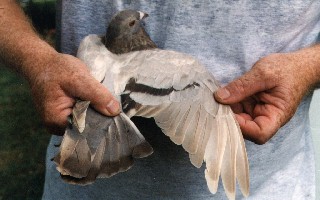Barless Pattern


Modified
for both Barless Pattern and brown color, left.
Modified Barless Pattern on wild type Blue color, right
.
Bar
Pattern


Wild type Bar Pattern on modified brown color, left, Wild type for both Bar Pattern and Blue color, right.

Ash-red
on wild type Bar Pattern
Checker
Pattern



Light
Check pattern in brown, left; checker pattern in blue, center; and dark
checker pattern in Ash-red, right.
Dilute
blue check pattern (properly called a Silver Check or Dun Check) is the
result
of the modifying gene called dilute. Here the dilute gene
changes the
color from blue/black to an almost brown check color on a
silver
background. Note that dilute will modify color but not the
pattern.
T-Pattern
or Velvet

T-Pattern: It gets its name from the small light colored T in the check pattern


T-Pattern Velvet with Kit Bronze left, Blue T-Pattern right.
Complex Modifiers
Now
we all know that our pigeons come in
many more colors and patterns than just those that are shown above. We
find birds with white markings while
others may be solid black, red or even white.
We have yellows,
gold’s, khakis and duns. We
have grizzles in various colors and we
fine some birds displayed as indigo and opals just to mention a few
example of these
modifications.
These
additional phenotypes or appearance
forms are due to the many genetic modifiers known to exist in our birds
gene
pool.
Modifications
to the pattern series would be
the barless and checker patterns and their presence simple means that a
wild
type bar gene has been altered into one of these other patterns. All
other forms of pattern change are modifications
in addition to and not in place of, these basic pattern forms. While
other modifiers may
alter our birds outward appearance by
replacing a gene somewhere in the wild type gene pool, they do not in
any way
eliminate the various patterns shown above.
Always
remember that when a birds basic
color of wild type blue or the pattern
forms listed above are hidden or masked,
these changes have not eliminate or replaced their true genetic color
or
pattern.
They have simply
modified or
masked them in some way resulting in different phenotype. Such
modifiers can hide a birds basic pattern
completely; they can alter a birds color and leave the patterns
unchanged or
they can do both as in a solid blue, brown, red, white, yellow or gold
etc. .
Regardless of what the modifier’s genes have done to the
outward appearance, the original
pattern and basic color inherited from its parents is still genetically
there
and can be transmitted independently of
the other
modifiers
to their own offspring.



The
black pigeon above on the left is a blue bar modified by the spread
gene to
become a black. If you look closely you can still
see the outline
of the bar pattern on its wing and tail. Here the normal
genetic pattern
is hidden by a color change from blue black to all black.
Genetically the
color hasn't changed from blue to black because in pigeons the
color we
call blue is really a form of black. Here the birds
color is simply
displayed in a different fashion, due to the effects of the spread
gene.
Spread changes the pigment distribution and in so doing has changed the
way
light is reflected off the bird (lessened) and therefore is seen by
your eye as
black.
The
bird on the center is a genetically a blue checker and its normal blue
checker
phenotype has been modified by the mutation known as Tiger Grizzle.
We
know she is genetically a blue check based upon her blue/black color
shade as the checks are the reason for the amount of dark
markings on the
wing shield. Tiger Grizzle depletes pigment totally in some
feathers
while not at all in others leaving the bird in a mottled
phenotype. In
addition, Tiger Grizzle does not affect the tail area .
The
hen pigeon shown above on the right is a recessive red (e//e) with
white,
dilute(d//d), blue(+//+) and check pattern genes
(C//C). So
under all of these modifiers is a blue check but what you see is a
golden
yellow and white bird. Here true basic pattern and her true
blue color are being masked but
none the less, they are genetically still there.
